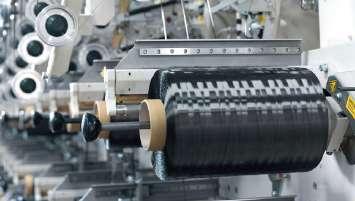44
DIGITAL PRINTING
pigment-based concentrates for screen printing. Helizarin inks contain multi-functional polymeric dispersing agents. These are said to produce prints which are comparable with results obtained using screen printing. Also, separate binders do not need to be used with Helizarin inks because the binders are already built in. The company claims that the elimination of a separate binder gives printed fabrics a soft handle, high levels of fastness, and good colour strength and brilliance. Helizarin inks contain pigments in the form of a low viscosity aqueous dispersion which is ideal for inkjet printing. With the aid of a proprietary pre-treatment process, Helizarin inks can be used on a wide variety of fabrics - including cotton, polyamide and polyester blends. The valve-jet process Another important development is the use of the valve-jet process to apply the ink to the fibres. This helps to prevent
problems encountered in inkjet printing when loose strands of fibres interfere with the flow of ink through the nozzles. Jets in the printhead are controlled by valves which open and shut independently. Streams of ink droplets are ejected at high velocity and the pressure from the valve is sufficient to ensure that inks penetrate deep into the surface of the fabric. Austria-based printing machinery manufacturer J Zimmer Maschinenbau has recently launched two new versions of its ChromoJet digital valve-jet textile printer, namely the ChromoJet 400 and the ChromoJet 1200. These machines are able to print spot colours, process colours and half-tones. Process colour technology prints four colours - cyan, magenta, yellow and key (black) - in the form of small dots or halftones. The colours may overlap, and are able to give a full range of visual effects. The technique is widely used to produce coloured illustrations in magazines and newspapers.
The ChromoJet 400 has valve-jets which can open and close up to 400 times per second, and can print up to 48 colours with a resolution of 1 million pixels per square metre. The machine can be used to print on carpets, rugs, furs and blankets. The ChromoJet 1200 has valve-jets which are capable of being opened up to 1,200 times per second. It prints to a resolution of 8m pixels per square metre and it can be used to print on towelling, upholstery, automotive textiles, corduroy and mats. Digital textile printing machines require the use of a different type of ink. ... Because of these special characteristics, digital inks are more expensive than inks for conventional printing and therefore increase the costs of digital textile printing. What is the cost of digital printing on fabric?
Type
Min Price
Max Price
Cotton
Rs.70/Meter
Rs.280/Meter
Georgette
Rs.100/Meter
Rs.120/Meter
Polyester
Rs.70/Meter
Rs.250/Meter
Satin
Rs.110/Meter
Rs.132/Meter
RETAIL UPDATE
5 D2C RETAIL TRENDS SHAPING CONSUMER-BRAND RELATIONSHIP MR. RAGHUNANDAN SARAF CEO & Founder, Saraf Furniture
2020 was a climacteric year, the Covid-19 pandemic brought industries everywhere to a grinding halt and changed the way the world lives and does business. The retail industry was impacted very hard by COVID, where sales have drastically dropped. The bulk of whole-sellers and indirect middlemen had been eliminated from the game due to the pandemic, which somehow unintentionally helped D2C (Direct-To-Consumer) E-Commerce. D2C brands are the ones that came out on top in retail marketing. The pandemic provided numerous opportunities for D2C brands to directly reach out to customers without the need for physical contact (as opposed to the SEPTEMBER 2021
traditional retailing process of selling to vendors, retailers, and resellers).That’s what business-to-business (B2B) usually does. In comparison to this method of retail, D2C is very convenient. D2C brands sell directly to customers without any middlemen. These brands work independently and do not depend on stores or any indirect middlemen to deliver their products directly to their customers. According to Good Rebels, “India’s digital transformation has taken off in a big way over the last several years. As of 2020, there are over 800 D2C start-ups in India with more than 100 million online shoppers. D2C brands are





















